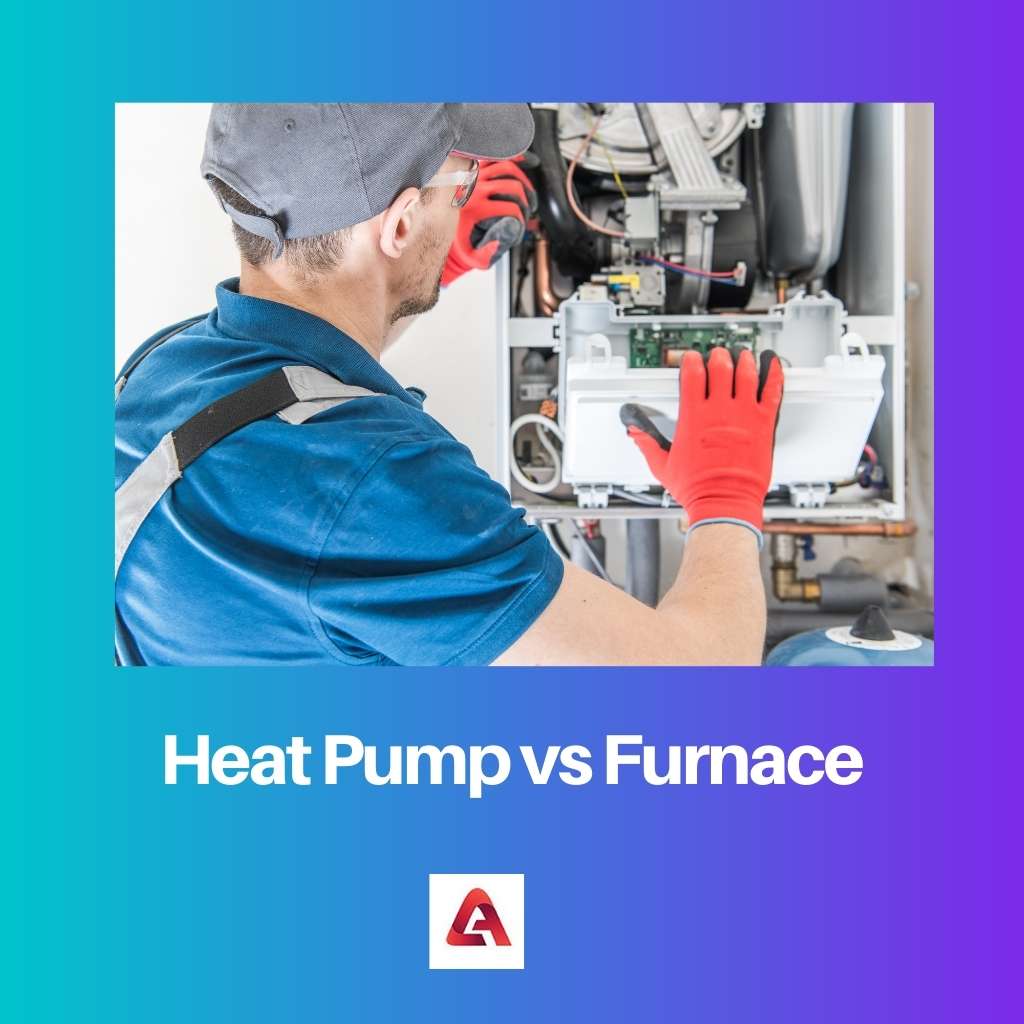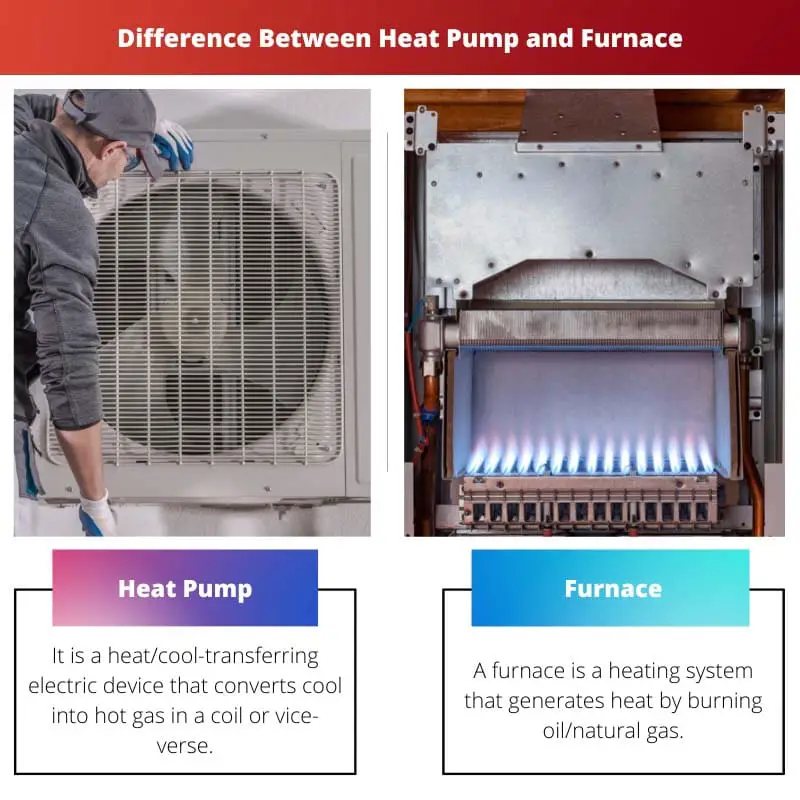Winters are really tiring, we need literally everything warm, thereby the invention of the heat pump and furnace saved our freezy nights into a warm one.
A heat pump is a heat-generating machine, where you have to process the refrigerator liquid into heat gas. Whereby, Furnace is a traditional heat-convector that is powered either by natural gas or oil or fuel.
Key Takeaways
- Heat pumps transfer heat from one location to another, while furnaces generate heat by burning fuel.
- Heat pumps are more energy-efficient and environmentally friendly than furnaces.
- Furnaces are more suitable for colder climates, while heat pumps perform better in moderate-temperature regions.
Heat Pump vs Furnace
Heat pump is a heating system that moves heat from one place to another using refrigerant to provide both heating and cooling. Heat pumps are more efficient in moderate climates. Furnace is a heating system that generates heat by burning fuel. Furnaces are more efficient in very cold temperatures.

A Heat Pump is also known as an air conditioner, where it pumps outside air and then transfers it indoors to either cool/heat the room.
There are six types of heat pumps based on thier sources; Hybrid heat pumps, water source heat pumps, exhaust heat pumps, air-source heat pumps, geothermal heat pumps, and solar-assisted heat pumps.
A furnace, also known as a heater or boiler is a home appliance that could generate heat throughout a building.
A basic furnace includes any one of these fuel types; natural gas, oil, electricity, and propane as its fundamental components, in order to generate heat.
Mostly, a traditional furnace encompasses the combustion of coal or natural gases on an enclosed surface.
Comparison Table
| Parameters of Comparison | Heat Pump | Furnace |
|---|---|---|
| Definition | It is a heat/cool-transferring electric device that converts cool into hot gas in a coil or vice-verse. | A furnace is a heating system that generates heat by burning oil/natural gas. |
| Invented | Peter Von Rittinger invented the first heat pump in 1855-1857. | Alice H. Parker is the inventor of the first Furnace in 1885. |
| Purposes | A heat pump transfers cool/hot air into warm or cool gas in an enclosed area. | The furnace is used for generating heat into the houses during the winter season & also for melting metals. |
| Mechanism | Processing with refrigerant liquid to the evaporator coil then releases gas into a compressor, which converts hot air. | Combustion of either natural gas or oil generates heat to the needed houses. |
| Expected life span | A well-maintained heat Pump effectively functions for up to 10-15 years. | Furnace’s life span is 20-25 years. |
What is Heat Pump?
The purpose of a heat pump is to move heat from a colder to a warmer environment. However, it is also used to cool an enclosed surface. In 1855-1857, the first heat pump in the world was introduced by Peter von Rittinger.
Compressor, condenser, expansion valve, and evaporator are four of the essential components of a heat pump. The first step in processing a heat pump is pumping the refrigerant liquid to the evaporator coil.
Secondly, it is absorbed into gas and enters into the compressor.
Following the pressurization of gas the temperature of the gas increases, and eventually turns into hot gas in the compressor coil. Thirdly, it comes through the condenser, where the excess heat is cooled off and condensed.
And lastly, the expansion valve reduces the pressure of the gas, and simultaneously, the process began again.
And this is how a heat pump extracts heat from one place to another by using mechanical energy.
Speaking of its cons and pros, the heat pump has lower running, maintenance costs, reduces carbon dioxide emissions, is reliable, long-lasting, environmental-friendly, highly efficient.
On the contrary, it is pretty difficult to install, requires electricity, has high upfront installation costs, extreme weather can malfunction the appliance.

What is Furnace?
Instead of owning an individual air conditioner, a furnace is installed permanently to provide heat for all residents in that building.
Furnace follows a traditional method where only clay, bricks, and a few elements are put in use. In the same way, the word Furnace is derived from the Latin word Fornax, meaning oven.
However, Alice H. Parker is given the credit of inventing a furnace powered by natural gas. A furnace is also used as an appliance for melting the metals, casting, changing elements’ properties and shapes, and many more.
Over and above, a furnace is classified into four categories based on thier efficiency and designs, namely, natural-draft, forced-air, forced-draft, and condensing.
Combustion of either natural gases or oil leads the furnace to an ignition system. Subsequently, this ignited air is stored in a combustion chamber and sent to houses through vents.
Furthermore, each type of furnace has its own cons and pros depending on its costs, efficiency, and source, for instance, electric furnaces cause higher utility bills, compared to other types of furnaces.
Nevertheless, furnaces are quite inexpensive, have a long lifespan, are very much reliable, and sometimes produce a large quantity of heat with a noisy blow fan.

Main Differences Between Heat Pump and Furnace
- The heat pump generates either cool air into warm air, vice-verse. Whereas, Furnace only releases heat air into vents of the houses.
- Heat pump has four fundamental components that are compressor, condenser, expansion valve, and evaporator. On the other hand, the Furnace has four components such as burner, heat exchanger, blower fan, and a flue.
- Heat Pump was invented by Peter Von Rittinger in 1855, but Furnace was introduced by Alice H. Parker later in 1885.
- Speaking of mechanism, A heat pump is a device that uses electricity to generate heat. Following the application of refrigerant liquid to the evaporator coil, gas is released into a compressor, which then transforms hot air and it passes through the condenser, which cools and condenses the surplus heat. . Meanwhile, the furnace’s ignition system is activated by the combustion of natural gases or oil. This ignited air is then kept in a combustion chamber and distributed to homes via vents and also used to melt things.
- Heat Pump is also known as air-conditioners. Nevertheless, furnaces are also called heaters or boilers.




